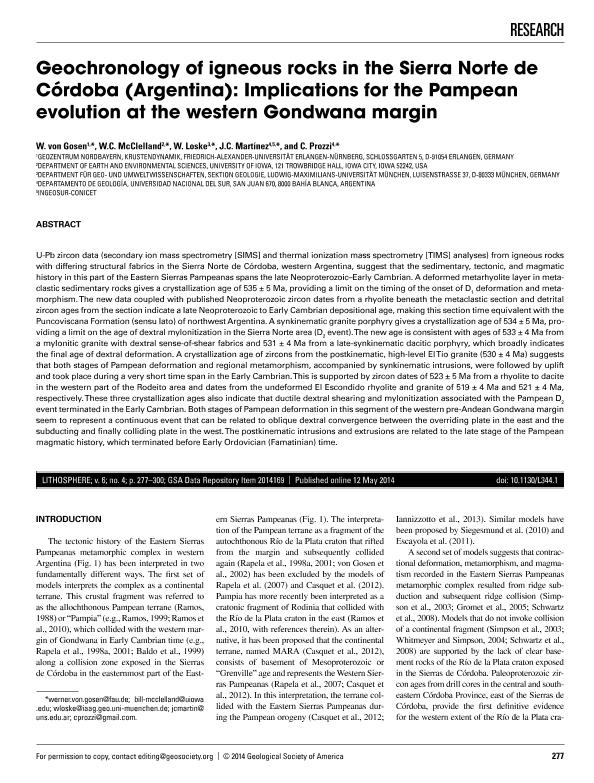Artículo
Geochronology of igneous rocks in the Sierra Norte de Córdoba (Argentina): Implications for the Pampean evolution at the western Gondwana margin
Fecha de publicación:
05/2014
Editorial:
Geological Society of America
Revista:
Lithosphere
e-ISSN:
1947-8264
Idioma:
Inglés
Tipo de recurso:
Artículo publicado
Clasificación temática:
Resumen
U-Pb zircon data (secondary ion mass spectrometry [SIMS] and thermal ionization mass spectrometry [TIMS] analyses) from igneous rocks with differing structural fabrics in the Sierra Norte de Córdoba, western Argentina, suggest that the sedimentary, tectonic, and magmatic history in this part of the Eastern Sierras Pampeanas spans the late Neoproterozoic–Early Cambrian. A deformed metarhyolite layer in metaclastic sedimentary rocks gives a crystallization age of 535 ± 5 Ma, providing a limit on the timing of the onset of D1 deformation and metamorphism. The new data coupled with published Neoproterozoic zircon dates from a rhyolite beneath the metaclastic section and detrital zircon ages from the section indicate a late Neoproterozoic to Early Cambrian depositional age, making this section time equivalent with the Puncoviscana Formation (sensu lato) of northwest Argentina. A synkinematic granite porphyry gives a crystallization age of 534 ± 5 Ma, providing a limit on the age of dextral mylonitization in the Sierra Norte area (D2 event). The new age is consistent with ages of 533 ± 4 Ma from a mylonitic granite with dextral sense-of-shear fabrics and 531 ± 4 Ma from a late-synkinematic dacitic porphyry, which broadly indicates the final age of dextral deformation. A crystallization age of zircons from the postkinematic, high-level El Tío granite (530 ± 4 Ma) suggests that both stages of Pampean deformation and regional metamorphism, accompanied by synkinematic intrusions, were followed by uplift and took place during a very short time span in the Early Cambrian. This is supported by zircon dates of 523 ± 5 Ma from a rhyolite to dacite in the western part of the Rodeito area and dates from the undeformed El Escondido rhyolite and granite of 519 ± 4 Ma and 521 ± 4 Ma, respectively. These three crystallization ages also indicate that ductile dextral shearing and mylonitization associated with the Pampean D2 event terminated in the Early Cambrian. Both stages of Pampean deformation in this segment of the western pre-Andean Gondwana margin seem to represent a continuous event that can be related to oblique dextral convergence between the overriding plate in the east and the subducting and finally colliding plate in the west. The postkinematic intrusions and extrusions are related to the late stage of the Pampean magmatic history, which terminated before Early Ordovician (Famatinian) time.
Palabras clave:
Western Gondwana
,
Deformation
,
Zircon
,
Metamorphism
Archivos asociados
Licencia
Identificadores
Colecciones
Articulos(INGEOSUR)
Articulos de INST.GEOLOGICO DEL SUR
Articulos de INST.GEOLOGICO DEL SUR
Articulos(SEDE CENTRAL)
Articulos de SEDE CENTRAL
Articulos de SEDE CENTRAL
Citación
Von Gosen, W.; McClelland, W. C.; Loske, W.; Martinez, Juan Cruz; Prozzi, Carlos; Geochronology of igneous rocks in the Sierra Norte de Córdoba (Argentina): Implications for the Pampean evolution at the western Gondwana margin; Geological Society of America; Lithosphere; 6; 4; 5-2014; 277-300
Compartir
Altmétricas




